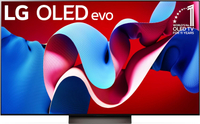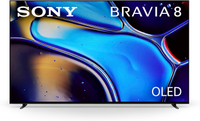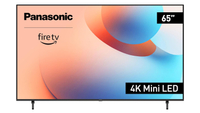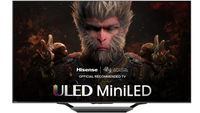Best 65-inch TVs in 2024 — Expert tested and rated
We've tested years' worth of 65-inch TVs — here's what you should buy right now
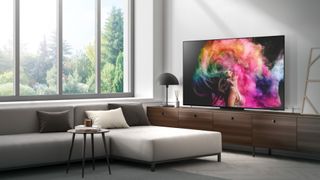
After over ten years of testing and reviewing popular TVs, I've learned a thing or two about the best 65-inch TVs. Picture quality is important, sure, but so is availability of certain features and price. The last thing any of us want to do is to spend more on stuff we don't need.
That's why I'm here to help get to the bottom of the best 65-inch TVs available today. It's a varied bunch: There are brilliant, top-tier OLEDs, mid-range Mini-LEDs, and affordable QLEDs under $500. But I'm familiar with all of them — from their best features to their hidden shortcomings.
65 inches is the most popular screen size for good reason. 4K TVs at the 65-inch size point represent the best choice for most living rooms, as they're best viewed from a distance of between six and nine feet. Right now, the best TV for most folks is the Hisense U8N Mini-LED TV, but there are picks for every lifestyle and budget, too.
The quick list
The best 65-inch TVs in 2024: quick list
Why you can trust Tom's Guide
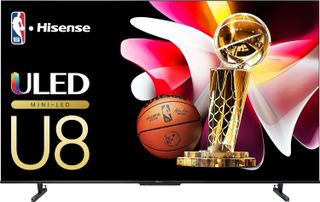
Picture ★★★★★
Features ★★★★☆
Value ★★★★★
Like its predecessor, the 65-inch U8N is a fantastic TV at a reasonable price. It delivers class-leading brightness and color saturation for right around $1,000.
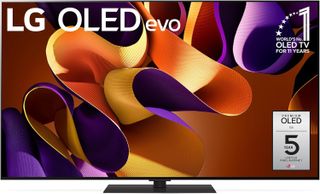
Picture ★★★★★
Features ★★★★★
Value ★★★☆☆
The 65-inch LG G4 OLED is more costly than the Hisense U8N by a wide margin (it's a premium OLED TV, after all) but the tradeoff is better contrast and color accuracy. If you want the best 65-inch TV at any price, the G4 is it.
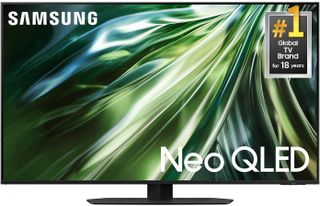
Picture ★★★★★
Features ★★★☆☆
Value ★★★☆☆
If you want a Samsung-made 65-inch QLED, look no further than the QN90D Neo QLED. This isn't Samsung's flagship QLED, but it's the one that offers the best combination of performance, versatility and value.
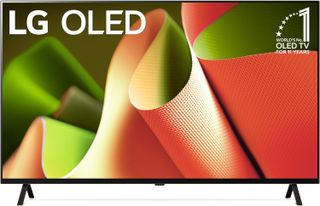
Picture ★★★★☆
Features ★★★★☆
Value ★★★★★
Dedicated gamers and A/V enthusiasts looking for an accurate picture will not be disappointed by the 65-inch B4, LG's entry-level OLED TV. While not as bright, it offers many of the same benefits as higher-end OLEDs.
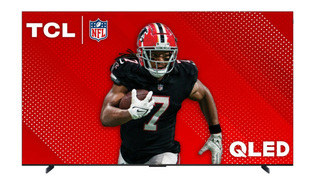
Picture ★★★☆☆
Features ★★★★☆
Value ★★★★★
The TCL Q6 is a decent performer with wide appeal due to its easy-to-use, built-in smart platform and low price. Right now, a 65-inch version is priced below $500, making it a great option for those shopping for a large TV at a friendly price.
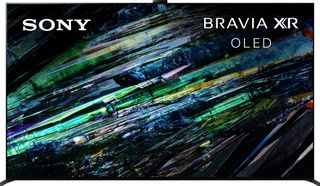
Picture ★★★★★
Features ★★★★★
Value ★★★☆☆
Look, if it wasn't several thousand dollars, the Sony Bravia XR A95L would be the best 65-inch TV. Unfortunately, it's the most expensive TV on the list by a country mile. It's glorious to behold, but it sure is pricey.
About the author

My name is Michael, and I’ve evaluated well over one hundred TVs in my day. The vast majority of these TVs have been 65 inches. My last TV was a 65-inch model, my current TV is a 65-inch model, and I'm almost certain that my next TV will be a 65-inch set, too.

My name's Nick and, for over a decade, I have been covering 65-inch TVs for major tech publications. Before I became Tom's Guide's Managing Editor of TV & AV, I was formerly the Senior Editor, TV and AV at TechRadar. Before my days in journalism, I helped folks just like you at a local Best Buy working in the TV department.
The best 65-inch TVs you can buy today
Best 65-inch TV
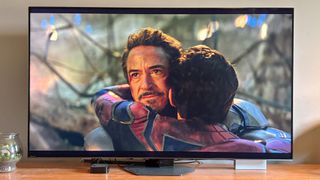

Specifications
Reasons to buy
Reasons to avoid
Everyone shopping for a 65-inch TV wants (nearly) the same thing: Good picture quality at a reasonable price. Yes, there are TVs that you could drop a few thousand on that will look wonderful (like the Sony A95L OLED) but most folks simply want a screen that works well, looks impressive and doesn't break the bank.
The Hisense U8N is that TV. It's a cutting-edge Mini-LED TV with several thousand contrast control zones for the best possible black levels while maintaining a peak brightness over 2,000 nits. It sports all of the essential streaming services on-board with its built-in Google TV smart platform, and it supports both Dolby Vision and the latest VRR technology. Add on top of all that a built-in ATSC 3.0 tuner that makes this TV capable of grabbing NEXTGEN TV content from over-the-air.
In our test results, the Hisense U8N delivered a peak brightness of 3,296 nits for some of the best-looking HDR content we've seen at this price range while covering 82.07% of the widest Rec2020 color gamut. It had slightly higher input lag than we'd like to see (13.1ms) but it was still very much under the 20ms needed for smooth gameplay. Finally, its color accuracy out of the box wasn't the best of any TV, but that's fixable with a few tweaks.
There are some slight hiccups in performance — older HD/SDR content doesn't look as good here as it will on, say, Samsung or Sony TVs with the newest AI-driven upscaling algorithms — but, for the price, you won't find any better option.
Read our full Hisense U8N Mini-LED TV review.
Best OLED TV
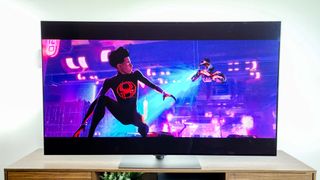

Specifications
Reasons to buy
Reasons to avoid
There are a lot of 65-inch OLED TVs to pick from in 2024, but if you're going to get one, I think the LG G4 OLED is the one to go for. Not only does this year's model come with a stand (something you would've had to buy separately in previous years) but it also offers the best performance of any LG OLED TV yet thanks to its next-gen META panel. Thanks to LG Display's latest Micro Lens Array technology, the G4 can get brighter for longer than any other LG OLED while still keeping colors accurate.
We tested the 65-inch version of this TV in mid-2024 and its numbers spoke for themselves. SDR brightness might've only peaked at 431 nits, but HDR was just shy of 1,500 nits — surprisingly high for an OLED screen. Color accuracy (measured by Delta E) was a crazy low 1.4041, which means that the G4 was one of the most accurate TVs we've ever tested. (The closer a Delta E score is to 0, the more accurate its colors are.) Finally, its UHDA-P3 and Rec2020 color gamut coverages of 97.17% and 72.91% are nothing to sneeze at, either. The Hisense U8N does perform slightly better in these areas, but it's relatively close overall.
If you want a premium 65-inch OLED, the LG G4 is this year's top choice.
Read the full LG G4 OLED review.
Best Mini-LED TV
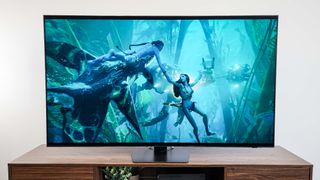

Specifications
Reasons to buy
Reasons to avoid
At the 65-inch screen size, competition is fierce. There are a lot of great TVs that could be on our list, but the one that keeps springing to mind is the Samsung QN90D. It's one of the best Mini-LED TVs of the year, as well as one of the top models from Samsung.
Our reviewer, Matthew Murray, heaped praise on this set for its impressive brightness and exceptional contrast. Like the Hisense U8N, the QN90D uses a blend of Mini-LED backlighting and quantum dots to deliver this level of performance. However, it also uses Samsung's NQ4 AI Gen2 Processor for better upscaling. Folks who own a Samsung mobile device will find some neat crossover features between it and the TV, and the TV's build-in smart platform, Tizen, is a good alternative to Google TV (though not quite as good, in my opinion).
Its four full-spec HDMI 2.1 ports for 4K/120Hz gaming are a huge boon for console gamers, however Tizen offers apps like Xbox and GeForce Now that let you game without ever hooking up extra hardware. It has similar test results to the other QLED TVs on the list, but these extra additions definitely help set it apart from the bunch.
Read our full Samsung QN90D Neo QLED TV review.
Best under $1,500
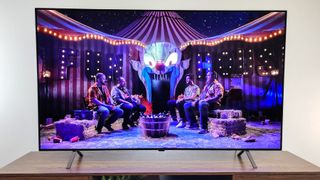

Specifications
Reasons to buy
Reasons to avoid
If you're looking for a phenomenal 65-inch TV for under $1,500, consider the LG B4. It's LG's entry-level OLED TV for 2024, and right now, you can land a 65-inch version for right around $1,200.
The B4's best asset is its OLED display, which allows for perfect black levels and ultra-accommodating viewing angles. Even at this price point, the B4's high-contrast picture is impressive; its inky black levels help elevate its relatively dim highlights (which we clocked around 660 nits).
When we evaluated the 65-inch B4, we were impressed with its picture processing, particularly its motion handling. Fast-paced action movies and sports looked especially good in our lab. It's also worth noting that, in LG's Filmmaker mode, the B4 offers fantastic out-of-the-box color accuracy. Movie enthusiasts and home theater aficionados will love this.
I'm willing to bet that most dedicated gamers will love the B4, too, as it offers most of the gaming enhancements found on higher-end LG OLEDs (support for 4K gaming across all four HDMI 2.1 inputs, for instance).
If you're looking for a little more brightness but still prefer an OLED, the 65-inch LG C4 can be found for around $1,500 to $1,700 right now. It offers a brighter picture than the B4 and support for 4K gaming at 144Hz. I wouldn't worry too much about missing out on the latter, but if your room is particularly sunny (or if you watch a lot of movies and shows with the lights on), the added cost might be worth it.
For most people, though, the B4 is a great compromise. It offers an impressive picture at a reasonable price.
Read our full LG B4 review.
Best under $500
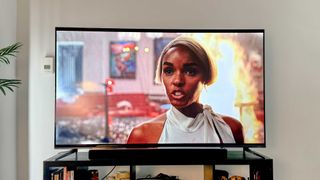
Specifications
Reasons to buy
Reasons to avoid
If you're shopping for a 65-inch TV on a budget, you ought to look into the TCL Q6. It's an affordable TV with wide appeal, thanks to some key features. Right now, the 65-inch version is just $450.
The Q6 won't turn heads the way a brighter, higher-end TV might, but its display leverages quantum dots for better overall brightness and color volume. This is one of the main reasons I'd recommend the Q6 over a more affordable 65-inch TV like the Samsung DU7200. It's not quite cut out for daytime viewing in a heavily sun-soaked room, but it most living spaces should be fairly accommodating for its modest backlight. Regardless of what you're watching — be it cable TV, Netflix, or an over-the-air broadcast — the Q6 looks great, especially in its most accurate picture mode.
The Q6 arrives with the Google TV smart platform baked right into the software — another win for the budget-oriented, set-it-and-forget-it crowd. Google TV is one of our preferred smart platform due to its ease of use and wide selection of downloadable apps.
Compared to a mid-range or high-end TV, there aren't as many gaming-related features on board, but the TCL Q6 nevertheless supports ALLM and VRR. And, although 4K gaming at 120Hz is out of the question, the Q6 is capable of showcasing 1080p and 1440p content at 120Hz, which could be nifty for semi-serious gamers.
If you want a better gaming TV (or just a better-performing 65-inch TV overall) and you still want to walk away feeling like you got a bargain, I recommend springing for the TCL QM8. Otherwise, the Q6 is a great all-around TV at a perfectly reasonable price.
Read our full TCL Q6 QLED TV review.
Best QD-OLED TV
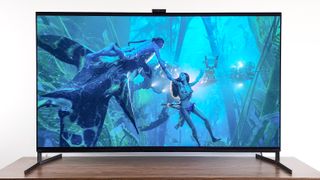

Specifications
Reasons to buy
Reasons to avoid
If I didn't have a mortgage to pay off, I'd highly consider buying the $3,300 65-inch Sony A95L OLED. It is a superb TV. Probably better than every other model on this list. But its price is three times that of our top pick, and twice as much as every other model. It's a great TV, absolutely, but it's not two or three times as good as the rest of the TVs mentioned above.
So why, exactly, does it cost as much as it does? The A95L OLED uses a QD-OLED panel just like the Samsung S95C above, but Sony takes things a step further by adding a ton of picture and audio-enhancing technology on top. There's the Cognitive XR Processor that creates truer-to-life colors and better motion handling, there's extra-wide viewing angle technology that prevents off-axis color desaturation, there's a Brightness Booster Max technology that helps push every possible pixel to its highest light output...the list goes on and on.
There are some downsides here that feel semi-inexcusable at this price (only two HDMI 2.1 ports, really Sony?) but those little critiques don't take away from how truly amazing this QD-OLED TV is for the lucky few who can afford one.
Read out full Sony Bravia XR A95L QD-OLED TV review.
Best 65-inch TV Test Results
Best 65-inch TV test results
| TV | HDR peak brightness (10% window) | Delta-E (lower is better) | Rec. 2020 gamut coverage | Input lag |
| Hisense U8N | 3,296 nits | 3.2 | 82.07% | 13.1ms |
| LG G4 | 1,487 nits | 1.4 | 72.91% | 9.2ms |
| LG B4 | 659 nits | 0.8 | 74.92% | 9.7ms |
| Samsung QN90D | 2,024 nits | 2.6 | 72.52% | 9.6ms |
| TCL Q6 | 498 nits | 2.1 | 68.92% | 8.9ms |
| Sony A95L | 1,215 nits | 2.8 | 89.41% | 16.1ms |
Other 65-inch TVs we tested
LG C4 OLED (★★★★☆)
The LG C4 is one of the best OLED TVs of the year. It costs significantly less than the aforementioned G4, but you'll still enjoy an incredible picture with decent HDR brightness (around 1,000 nits). It also offers a comparable selection of gaming features as the G4, which is a huge point in its favor.
Read our full LG C4 OLED review.
Sony Bravia 8 OLED (★★★★☆)
The newest Sony OLED is the Bravia 8, and while we found it to be relatively dim compared to competitive OLED TVs like the LG C4, there's no denying that Sony's upscaling and overall picture processing make it an attractive option for viewers with a discerning eye. It's worth noting that it's gaming features aren't as robust as the C4, however.
Read our full Sony Bravia 8 OLED review.
Panasonic W95A Mini-LED TV (★★★★☆)
The Panasonic W95A is a Mini-LED with some serious performance chops. In our tests, the W95A impressed us with HDR highlights approaching 1,500 nits and fantastic out-of-the-box color accuracy. We weren't that jazzed about its built-in, Amazon-based Fire TV smart platform, but in terms of performance and gaming support, the W95A is up there with the best Mini-LED TVs of 2024.
Read the full Panasonic W95A Mini-LED TV review.
Hisense U7N (★★★☆☆½)
This is Hisense's mid-range Mini-LED TV for 2024. It's not as bright as the higher-end U8N (nor is its local dimming as capable), but it's a much better option for gamers and home theater enthusiasts on a budget than the 65-inch TCL Q6.
Read our full Hisense U7N review.
How to choose the best 65-inch TV for you
How to choose the best 65-inch TV for you
If you're in the market for a new TV, you'll want to consider a few factors before you spend your money. Our TV buying guide breaks down the fine details of what features matter and what distinguishes a great TV from one that's just okay. For a 65-inch set we strongly recommend going with 4K resolution. There are a few older 1080p models still available, but they simply aren't a good value today. And while 8K TVs are hitting the market, it will still be some time before 8K resolution gets mainstream support.
Size and space: For a 65-inch 4K TV you'll want to sit between 8 to 9 feet from the screen to hit the sweet spot of being close enough to enjoy all the sharp details, but not so close that you'll be able to make out the pixels that make up the picture.
Price: A basic 65-inch 4K smart TV will range between $500 and over $3,000, depending on how much you're willing to spend on performance and features. The TCL Q6, our current pick for the best budget TV, is priced right around $500 for a 65-inch model, while the LG G4, our pick for the best OLED TV, is priced at around $2,300.
Features: For the best picture, we recommend getting a set that offers high dynamic range (HDR) support. HDR10 is the base standard, while Dolby Vision is a higher-caliber format, and we recommend opting for Dolby Vision support when you have the choice. To learn more about whether or not this format is essential for your purposes, check out our guide on the importance of Dolby Vision.
Ports: Port selection ought to be a primary consideration. More HDMI ports will let you connect more devices, like game consoles and satellite boxes. Typically, TVs offer four HDMI ports, but budget-oriented models (like the TCL Q6) often arrive with just three. In addition, if you have a soundbar, you'll probably want to connect it using an HDMI port with eARC (a standard feature on almost all TVs). Lastly, TVs use one or two HDMI formats: HDMI 2.0 and HDMI 2.1. Mid-range and higher-end TVs will offer at least two HDMI 2.1 inputs, which will unlock several enhancements, most of which are gaming-centric. To learn more about these HDMI types, check out our HDMI 2.1 explainer.
Software: For people who don't intend to use one of their TV's HDMI ports for a dedicated streaming device, finding a reliable smart TV platform is essential. Companies like Samsung and LG use their own proprietary software, but many use more broadly available software, like Google TV and Roku. The biggest issue is app selection, as some specific apps you may want won't be available on every smart TV platform, or there may be a months-long delay for a new service to come to some smart TVs after launching on others.
But you'll also want to look into more advanced features, like smart home control, video conferencing capability, and other features that may be brand exclusive, or at least unevenly distributed between premium and budget sets.
How we test the best 65-inch TVs
How we test the best 65-inch TVs
When it comes to evaluating TVs, we're serious about getting it right. That's why every TV we review is put through a rigorous testing process that measures key standards of picture quality and performance.
Our lab tests involve testing for color accuracy and color gamut using an X-Rite i1 Pro spectrophotometer, an AccuPel DVG-5000 video test pattern generator and SpectraCal CalMAN Ultimate calibration software. These tools are relied on by professional calibrators throughout the industry, and we've paired them with custom workflows to gather the information needed for our reviews. These measurements are taken first in standard mode to simulate the average watching experience, and then taken again in other display modes to find the top color and brightness performance offered by each set.
Our testing measures contrast and maximum brightness, as well as lag time. Using a Leo Bodnar Video Signal Input Lag Tester to test video signal delay, we time how long it takes for content to travel from the original video source to the screen, measured to the millisecond. Shorter response times equate with faster gaming performance, letting us objectively know which TVs are better for gaming.
We use all of these objective test results to make comparisons about quality and performance between different TVs, but our evaluation doesn't end there. We also spend hours with each set, watching shows and movies, and using carefully selected video samples to highlight the strengths and weaknesses of each set and help us tell you which TVs look and sound the best in a real home viewing environment.
And there's more to today's TVs than just viewing, so we also check out the smart TV functions and evaluate everything from the interface to the remote control design. This lets our reviews speak to the technical capabilities of today's smart TVs and how they fit into your connected home.
- Smart TV FAQ: Everything you need to know
- The best gaming TVs for consoles old and new
Sign up now to get the best Black Friday deals!
Discover the hottest deals, best product picks and the latest tech news from our experts at Tom’s Guide.

Michael Desjardin is a Senior Editor for TVs at Tom's Guide. He's been testing and tinkering with TVs professionally for over a decade, previously for Reviewed and USA Today. Michael graduated from Emerson College where he studied media production and screenwriting. He loves cooking, zoning out to ambient music, and getting way too invested in the Red Sox. He considers himself living proof that TV doesn't necessarily rot your brain.
- Ryan EppsStaff Writer
-
ToesNose "you'll get the best viewing experience seated 60 inches (5 feet) from a 65-inch 4K screen" Really 5' from a 65" TV for the best viewing experience, is that with or without my Mr. Magoo glasses? ROFLReply -
JimmyPeanuts I wouldn't buy the LG tv. I feel obligated to share my experience with two LG TVs that were previously ranked #1. I won't make this mistake again. In 2019 I bought the top ranked OLED TV, which was the LG OLED 65". I also bought a smaller LG TV for a bedroom. After owning the TV for 14 months, the 65" TV began turning off whenever I tried to access the smart apps. Basically the TV doesn't work. Also, it developed a horizontal black line on the screen. I researched both issues, and these issues are VERY common problems on LG TVs, with no solutions. I called their support line, and spoke with a man in India. He refused to help me because the warranty expired two months ago. He referred me to a local repair shop. They told me BOTH TVs will continue having this problem, even if fixed today, and they recommended I buy another TV and ANOTHER BRAND. Anything but LG. Buyer beware. I mean no disrespect to Tom's Guide or any other site that ranks LG as #1, but I do wonder if they are paid for these reviews, and if my comment will be allowed on their forum. I'm typing this because I feel it's the right thing to do. Don't buy LG.Reply
